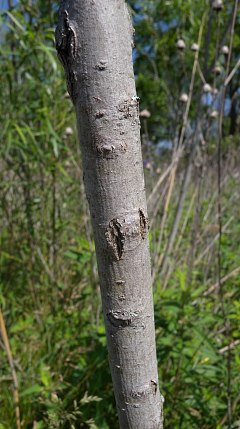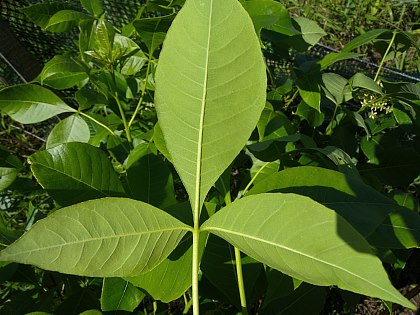Description: This shrub is up to 20' tall with an irregular rounded crown, forming a central trunk up to 6" across. Sometimes multiple branches are produced from the ground, instead of a trunk. The bark of the trunk and larger branches is grey and slightly rough. Smaller branches have bark that is more smooth and gray-brown.

Alternate
trifoliate leaves are produced on new stems that are green, terete, and
usually hairless. The leaflets are 2-4" long and 1-2" across; they are
narrowly ovate to ovate, smooth or slightly toothed along their
margins, and sessile. The leaflet upper surfaces are medium to dark
green, hairless, and shiny, while the lower surfaces are pale green and
hairless (rarely pubescent). The bases of the leaflets are
wedge-shaped, while their tips are slender and pointed. The petioles of
the trifoliate leaves are light green, terete, hairless, and about 2-6"
long. Occasionally, umbel-like panicles of flowers are produced that
are 2-3" across. Wafer Ash is monoecious, often producing male, female,
and perfect (bisexual) flowers on the same shrub. Regardless of gender,
individual flowers are a little more than ¼" across. Perfect flowers
have 4-5 petals, 4-5 sepals, 4-5
stamens, and a single flattened pistil that is green and
obcordate-orbicular in shape. The petals are whitish or yellowish green
and narrowly lanceolate-oblong. Male flowers lack the central pistil,
while female flowers lack stamens. The slender pedicels of the flowers
are light green and hairless. The blooming period occurs during the
late spring and lasts about 2 weeks. Each flower with a pistil develops
a flattened fruit that is broadly winged along its margins and about
¾–1" across. The winged margins of the fruit have a reticulated network
of fine veins, while its center contains 2-3 seeds. Immature fruits are
green, but they become light brown at maturity. The root system is
woody and branching. Clonal offsets from underground runners are
not produced.
petals, 4-5 sepals, 4-5
stamens, and a single flattened pistil that is green and
obcordate-orbicular in shape. The petals are whitish or yellowish green
and narrowly lanceolate-oblong. Male flowers lack the central pistil,
while female flowers lack stamens. The slender pedicels of the flowers
are light green and hairless. The blooming period occurs during the
late spring and lasts about 2 weeks. Each flower with a pistil develops
a flattened fruit that is broadly winged along its margins and about
¾–1" across. The winged margins of the fruit have a reticulated network
of fine veins, while its center contains 2-3 seeds. Immature fruits are
green, but they become light brown at maturity. The root system is
woody and branching. Clonal offsets from underground runners are
not produced.
Cultivation:
Wafer Ash is typically found in full sun to light shade, mesic to dry
conditions, and rocky or sandy soil. This shrub may fail to flower if
it receives too much shade.
Range & Habitat:
The native Wafer Ash is widely distributed and occasional in Illinois
(see Distribution
Map). Habitats included mesic to upland deciduous woodlands,
woodland edges and openings, mesic to upland savannas, rocky bluffs,
thickets, stabilized sand dunes with woody vegetation, limestone
glades, and fence rows. This shrub can be found in high quality to
somewhat degraded habitats.
Faunal Associations:
The flowers attract small bees, wasps, flies and ants. These floral
visitors feed on the nectar of the flowers primarily, although some
small bees also collect pollen. The caterpillars of the butterfly Papilio
cresphontes (Giant Swallowtail) feed on the leaves of Wafer
Ash; this is one of the few food plants of this species in Illinois.
Another specialist feeder is the thrips Neohydatothrips
pulchellus, which sucks juices from the leaflet undersides.
Other insects that feed on Wafer Ash include the caterpillars of the
moth Yponomeuta atomocella (Brown-Bordered Ermine
Moth) and the larvae of the Scolytid beetle Phloeotribus
scabricollis, which bore into the bark and wood. White-Tailed
Deer probably don't browse on the leaves and twigs to any significant
extent, as they have an unpleasant scent and bitter taste.
Photographic
Location:
Edge of a restored prairie at Meadowbrook Park in Urbana, Illinois.

Comments: Perhaps the most attractive feature consists of the wafer-like fruits, which resemble the samaras of Elm trees (Ulmus spp.). Otherwise, this rather unique shrub does not attract much attention to itself. Notwithstanding its common name, Wafer Ash is not one of the true ashes (Fraxinus spp.), which are members of the Olive family (Oleaceae). Another common name of this shrub is Hop Tree, because it was used as a substitute for hops in brewing beer. Different varieties of this shrub have been described across its wide range in the United States, but most specimens in Illinois correspond to the typical variety.